4 - 7 July 2011 - July Working Week
Monday 4th July (DAY ONE) Last year Jason had repainted the left hand side of the engine and when time came to refit the L/H exhaust system he booked a week off work and it took him all week (and then some) to complete the task, going on the experience he had with refitting this complex exhaust system he again booked a week off work now that the R/H engine painting has been mostly done and the exhaust system is now ready for refitting, this time though he was better prepared and had set out an 11 step plan for the Exhaust refit. 1) Complete the Dismantling of the as removed Exhaust pipes (and retain all bolts) As Jason would probably be working on his own this week he hoped to get at least 2 of the steeps completed each day, if the job overran (as it did last year) then the following weekend was a scheduled D8233 working weekend anyway so additional help would be available then to finish the job off. So Jason started the Monday morning off with Step 1, as the exhaust had been taken apart in sections most of the pipes were still bolted together and these needed to be fully dismantled, Jason started on this task, clamping the pipes in the workbench vice then undoing the bolts some of which had heat seizure and would either strip the threads in coming off or shear off completely, while he was doing this he was joined by Tom Leahaye, a man from Holland who often comes over the UK to ride behind vintage Locos and had been over for the ELR July Diesel gala the three days previous, as he had a spare day before he had to fly back to Holland, Jason had spoken with him the day before and suggested that he might come down and assist him with the Exhaust Refit on D8233, so he turned up ready to work and he helped Jason finish off the pipe dismantling, Step 1 completed 10:23, next it was onto step two, Jason set up two of the aluminium stages outside and prepared some bowls of warm water with washing up liquid in, then Jason and Tom set about scrubbing down the pipes one at a time, there were 16 pipes in total to do, and when all had been thoroughly washed they were swilled off with water and allowed to air dry, Step 2 completed 11:21, they then had a tea break when they waited for the pipes to dry off after which it was on with step three, this was done on the out side work bench, Jason operated the angle grinder with wire wheel attachment and Tom held the pipes steady while he drelled them, the ring pipes needed a slightly different tactic to do the ring joints, they were bolted to the bench while Jason went around the rings with the wire wheel, some of the ring grooves were full of carbon, this needed to be scraped out as best Jason could using a screw drive, Tom also noticed that the mounting flange on one of the ring pipes had a crack across one of the corners, so Jason made a note of it and would resolve to get a spare from the parts store later, Step 3 completed 11:59, Next it was step four, and back into the coach, Jason clamped the pipes in the work bench vice while he used the angle grinder to grind out clearance notches into the lagging collars this is to aide the access to the bolts with a socket set which will make the job of reassembly easier, while Jason was doing this Tom went to the outside bench and was cleaning up the fire rings using emery paper and so Step 4 completed 12:55, then they both decided to stop for a lunch break. After Lunch it was on with the next job, step five, this was again done on the bench outside, Tom (who is into body building and keeping fit) is a strapping Man and his muscle was very useful in tightly winding the lagging wrap around the many pipes, the straight pipes were simple enough, Tom would start at one end, wrap the lagging tape around in a spiral fashion making sure to overlap the tape slightly as he went, then when he reached the other end of the pipe Jason cut off the excess and then secured the lagging in place by tying thin wire around it, some of the other pipes with bends in and manifold flanges were more of a challenge to wrap by and the last pipe they had nearly run out of lagging, but fortunately the last pipe did not need so much lagging, so it worked out ok in the end though they were a little itchy with all the stray fibreglass fibres everywhere, Step 5 completed 14:39, The next task was to begin step six, cleaning up all the bolts, as some had been snapped and damaged replacements would have to be sourced but for now they would work with what they had, they set up a little production line, Tom was on the work bench vice clamping bolts in to it then using the Die brace would run the die down the threads to clean them out then hand the threaded bolts to Jason who drelled them up using the wire wheel on the bench grinder, the nuts were treated in a similar manner, they would be clamped in the vice the Tom would run a tap through them using a rechargeable drill and plenty of WD40, when a nut and bolt set had been fully cleaned & threaded it was put together and put in a pot with the others. this work continued until around 17:30 when Tom had to make ready to depart, Jason Thanked him thoroughly for helping him out during the day, Thanks to Tom’s assistance he was well ahead of schedule on the jobs list and especially with the bolt cleaning task which is the longest and most tedious task of all to do, they had made huge progress on that front and Jason was certain that he would get the Exhaust finished before Friday and it was all Thanks to Tom help, anyway he said his goodbyes and Jason finished the day off by gloss painting the central cooling knuckle as he needed that painting for when he would re-assemble it later in the week. Tuesday 5th July (DAY TWO) After the getting nearly half the jobs done in one day thanks to the massive help provided by the Tom the big Dutchman, Jason was now well ahead of schedule and was now confident that he would get the Exhaust refit done by Friday, so to begin today he had the bolt cleaning operation to finish off, as he was on his own, he would have to do both the threading and drelling tasks individually instead of having Tom feeding him with pre-threaded bolts, so the remainder of this task did take twice as long as it did before, While doing this Jason remembered that he had used some of the bolts to fit the blanking covers to the cylinder head ports so he went around to the loco and removed the blanking covers and recovered the bolts, taking them back to the coach for cleaning, it was Jason’s intension to have a complete set of fully cleaned bolts ready for when he begins the refitting of the pipes, but as some of the original bolts had been damaged or broken he needed to get some spares, so a trip up to the store unit was required, in the store he had to clear some of the other stuff out of the way before he could get to the spare exhaust pipe that he would remove the replacement bolts from, while he was there he recovered a spare ring pipe to swap with the one that had a cracked flange on it, soon he had enough bolts to finish the task and went back to the coach, the replacement bolts also required cleaning up so Jason processed them first, he the arranged the bolts into two sets, one for the rear section of the exhaust system and one for the front, finishing off this task had taken most of the day, Step 6 completed 14:38. Jason now moved onto something else, other unrelated tasks that he could do with completing before the exhaust refit, so he went to the loco now in the Baron Street loco works, now the walk board that usually sit on top of the buffers at the front of D8233 had been removed when the shunt was done, Jason used the wheel barrow to bring it around to the loco and using one of the ratchet straps he secured it to the buffers with the strap to prevent rocking around when people waked across it, He the went onto the engine and using a screwdriver scraped out the gutter that runs just below the water jackets along the side of the block, this leads to the block drain pipes situated at either end of the block, after painting this gutter had become blocked with paint and other crud that had fell down from the cylinder water jackets above, after he’d cleaned out the gutters, he used the drill with threading tap fitted to tap out all the bolts holes in the cylinder head exhaust port mounting flanges, after which he had some of the wood pigeon gloss paint and painted some of the more accessible areas of the bedplate which was currently in grey undercoat, after this he returned to the coach and began step seven, Jason had learnt his technique for refitting the ring pipes to the cooling knuckle last year by utilising a pair of large jubilee clips as makeshift ring compressors, first he drelled up the replacement ring pipe he had got from the store to replace the one with the cracked flange, he then laid the knuckle out on the bench then he arranged the rings on one of the pipes so that the gaps were suitable spaced apart, then he carefully fitted the ring compressor clips one at time, once they were in place he lined the pipe up with the bore then tapped it down gradually using the dead blow hammer, sometimes the ring compressor clips would come adrift and the pipe would have to be pulled out and reset to try again, once the three ring pipes where fitted on one side he flipped the whole assembly over and by supporting it with some blocks of wood, he tapped the remaining three ring pipes home, this job too had been quite time consuming, Step 7 completed 18:07, however everything was ready for the exhaust reassembly to begin the next day so Jason sorted out all the bits he would need to build the rear section and that was the end of day Two. Wednesday 6th July (DAY THREE) Today would see the start of the Exhaust system refit proper, but first a certain amount of “house cleaning” was required on the Loco, D8233 as you know is now inside the Baron Street Loco work having taken the place of Class 14 D9531 after it was moved to Buckley Wells carriage works across the road to begin its repaint, D8233 was shunted into position and has pretty much remained as it was after the tarp was removed, so much of the equipment & junk that was stored on the loco up that point was still there, However firstly the loco needed to be plugged back in, fortunately there was a nearby 16 amp power socket that Jason was able to plug the loco in to by utilising one of the 16 amp extension cables, next there was the thin metal box section frame (bars from the C15PS sales stand) that were erected at the No2 end to act as a temporary support frame for the tarp, this is now not needed and needs taking away, so Jason climbed up onto the 2 end and began dismantling the frame, there were some other bits up there that also needed to be taken away, like the lifting beam a section of large channel that was used in the engine compartment to secure the block an tackle when lifting up heavy auxiliary motors, after lowering the stuff down to the deck, Jason borrowed one of the wheel barrows from outside the steam department stokers office and using it transported the poles and beam around to Paddy where he placed then in to storage, next he had to collect the old air starter motors, these came fitted to the replacement engine and we had tried to use them to turn the engine over at the first failed start-up attempt in May 2008, since removal these have remained on or around the loco awaiting a decision on their fate, Jason however had texted Chris Baily and asked him what to do with them (as they were in the way?) He said that they of no use any more and could be thrown away, so Jason still using the wheel barrow first collected the R/H Air starter that was lying on the floor next to the wall of the works where the loco previously stood, it had lain there since being pushed off the sole bar, Jason collected it up and took it round to the scrap skip and dumped it, then back to the loco to fetch the second motor which was sat on the L/H sole bar, that too was removed and dropped into the scrap skip, that done he used the wheel barrow one more time to fetch the first lot of Exhaust pipes that which would make up the rear section and bought them around from the coach to place them upon the sole bar of the loco, After returning the wheel barrow, Jason had one more prep job to do before making a start on the pipe re-fitting, He used a drill fitted with a small wire cup to drell the faces of all the exhaust port flanges on the cylinder heads and ring pipe flanges on the turbo cooling knuckle, it was now time at last to begin step 8. Refitting of the rear section went surprisingly smoothly, thanks to all the work in preparing the pipes and bolts and having all the necessary tools to hand as well as prior knowledge of how best to do the job, Jason completed his fitting of the four pipes that make up the rear section in just over an hour making sure not to tighten the bolts too much but leave the system loose so that there would be enough movement to allow for flexibility when aligning the awkward central cooling knuckle section, but that was Step 8 completed 13:06, Jason would now stop for his lunch break, after break to begin step nine Jason borrowed the wheel borrow again to transport the Cooling Knuckle assembly round from the support coach to the loco, he also fetched the Chain block & Tackle and the short lifting strops, now fitting the cooling knuckle is very awkward, it has 3 flanged ring pipes and one bolted gasket flange on each side, the alignment of the bolted flange is crucial, Jason had planned to use the block & tackle to hoist the knuckle up into position and support the weight while he got a bolt started, firstly through he had to fit the fire ring exhaust seals into the circular recesses in the ring pipe flanges, Jason knew from experience that these had a habit of falling out, so to hold them in place he used small rolled beads of Bluetack to push in between the ring and the seat and this worked perfectly to hold the fire rings in place when the pipes were assembled, however when he set the block & tackle to lift the knuckle into place he soon discovered that he could not lift it up high enough as it was lashed around the roof line hand rail using one of the small strops, so he had to abandon that attempt. It was at this moment that Chris Guntripp appeared and was curious to see what was going on the Class 15, Jason asked if he could help out and he agreed, so the pair of them struggled to get the knuckle into position while Jason tried to get a bolt started, it took around 4 tries before Jason finally got a bolt in so that the knuckles weight was supported by the exhaust, Jason thanked Chris for his assistance and continued to bolt up the flour flanges on the aft side of the knuckle, Step 9 Completed 15:30, It was straight onto step ten, rebuilding the front section but as time was getting on and given all the work that Jason had done that day already he only fitted the inner duel branch pipe for cylinders 4 & 5, this was a tricky fit in itself due to the solid flange mounts both to the heads and the cooling knuckle, but eventually and with much scraping of paint on the engine Jason got the manifold into position and loosely bolted it up, but by this time it was 16:30 and he had to vacate the works as Riley’s engineering was ending their shift and shunting up the works so Jason had to return to the support coach where he gloss painted the coolant pipes that go with the cooling knuckle, and then he straightened out some of the block drain pipes using the work bench vice and drelled them back to bare metal, that ended the days work. Thursday 7th July (DAY FOUR) Jason went for breakfast early on Thursday morning confident that he would complete the exhaust refit today, back at the loco he continued with step ten, refitting the front section was a lot easier this time around then it had been when he rebuilt the L/.H exhaust system last year, the main reason being that this time around Jason had fully dismantled the pipe section instead of leaving the front pipes intact as he had done before, the down side of this was their were many fire ring joints to content with, but thanks to Jason new assembly technique of using small rolled beads of BluTack pressing into the ring seats this was no longer an issue, and he was able to quickly bolt up the remaining pipes until the exhaust system was once again complete, Step 10 Completed 10:05, it was then onto the final task, step eleven, that is going around all the bolts and flanges to make sure that everything was tight, Jason had bought round a heap of 3/8th socket extensions an wobbly joints for this very purpose, for the Cylinder head flanges he used a 1/2 inch Socket, extension and torque wrench to torque up the head flange bolts to 120nm so as to properly compress the new exhaust gaskets he had used, some of the bolts was a little difficult to get to especially the ones on the bolted flanges on the cooling knuckle but eventually all was tight and the job of refitting the exhaust was finally finished, Step 11 Completed 11:55, after this he got the gloss paint again, to touch up the areas on the engine and lower coolant pipe that had been damaged by the manhandling of the pipes, then he finished off the painting of the bed plate box section using the mirror to help get the paint into the inaccessible corners using the angle brush, by then it was Lunch time so he stopped for some food. After lunch, Jason returned to D8233 went over to the No2 end as earlier in the week he had noticed that there were some parts on the underside of the compressor that had not been painted, so using the wood pigeon gloss and an angle brush he went around and touch up painted the missing stops on the underside of the air compressor, after this he went onto do some work on both D5705 and D9531 and this would preoccupy him for the rest of the day. Friday 8th July (DAY FIVE) As the Exhaust job was now finished and other jobs on the other locos were not that important Jason was at a bit of a loose end during the morning session so he decided to spend the time giving the C15PS support coach a little TLC for once, he had a bit of a tidy up in the workshop, kitchen and sitting room areas, then went to B&Q and bought a few bits that he felt would benefit the coach, the rest of the morning he spent fitting these items. In the afternoon he did a quick painting job on D9531 before deciding to continue with the renovation of the block drain pipes, having drelled up three pipes back to bare metal along with the mounting clamps and bolts he took all the bits that he had around to the loco to try and fit the pipes, as he had straightened out the pipes they needed to be bent back into shape, fortunately the C15PS have a small pipe bending machine that Jason used to put the 90 deg bends back into the pipes after he had made the necessary measurements as to where the bends should go, eventually he had two pipes mock fitted to the engine, however it was at this time that a ELR Loco works member came round and told Jason that the works would shortly be locked up, it was only 15:45 but then he guessed that the loco works closes up shop early on a Friday, so he had to quickly dismantle the pipes and gather up all the tools before taking them back to the coach, in the coach he primer painted the two drain pipes that he had managed to get into shape and test fitted, that ended his work week. Things had gone much smoother than Jason had anticipated but this was mainly due in part to the help provided to him by Dutch Tom on the Monday that got him ahead of schedule also after learning from his experience of fitting the L/H exhaust system the year before he was able to be better prepared this time around and it all made for a much quicker and easier job well done.
The next working weekend is September 3/4. If you wish to lend a hand please contact Chris Tatton |
 |
| © C15PS |
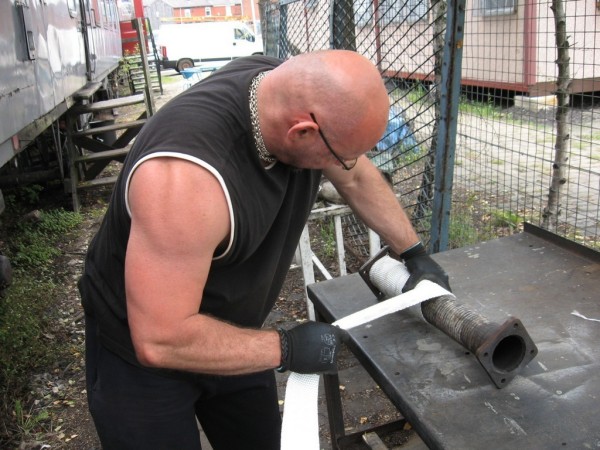 |
| © C15PS |
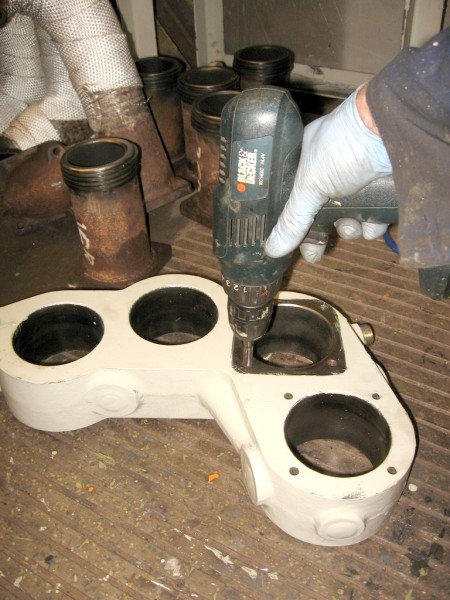 |
| © C15PS |
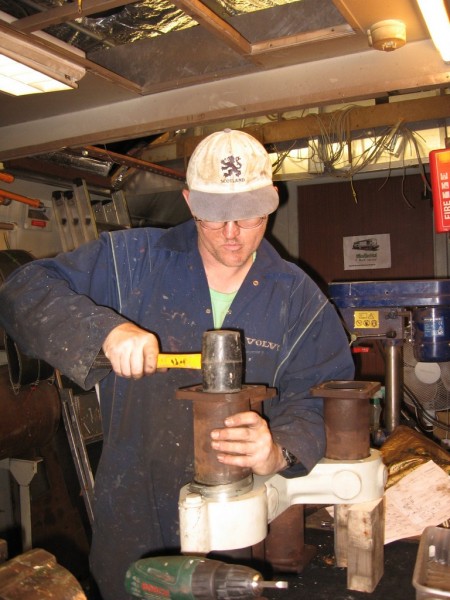 |
| © C15PS |
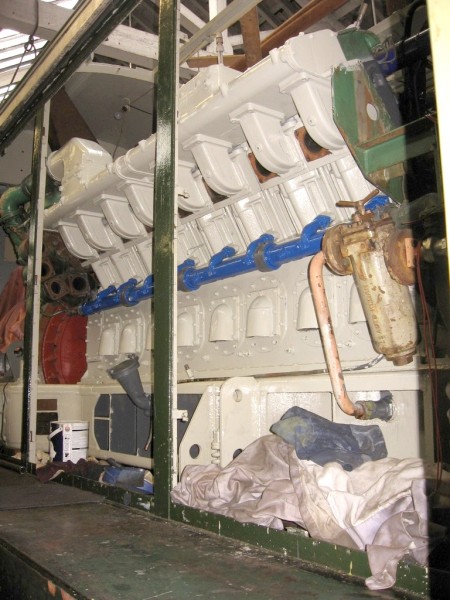 |
| © C15PS |
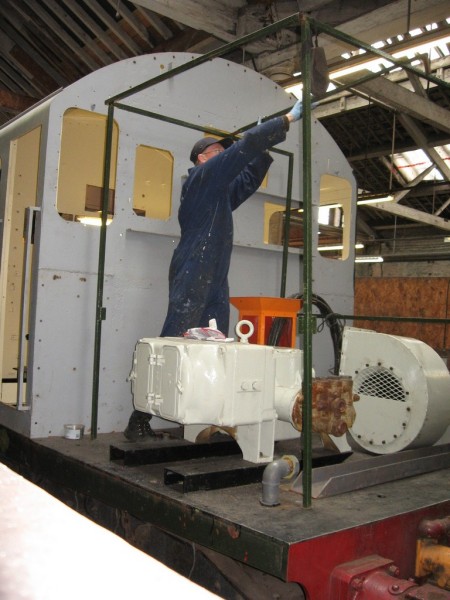 |
| © C15PS |
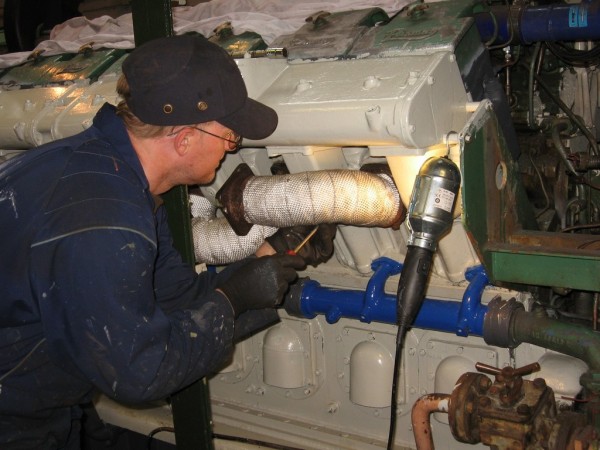 |
| © C15PS |
 |
| © C15PS |
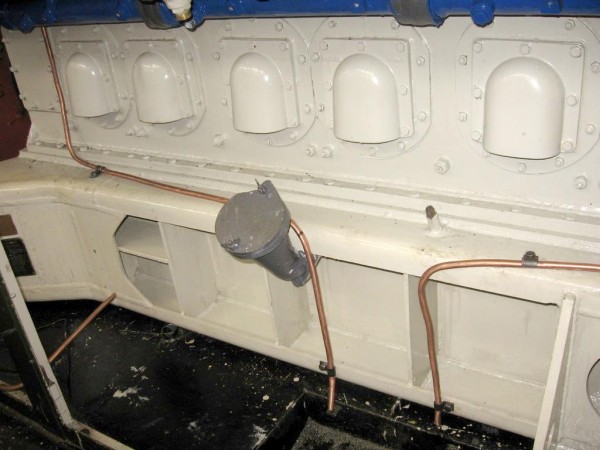 |
| © C15PS |
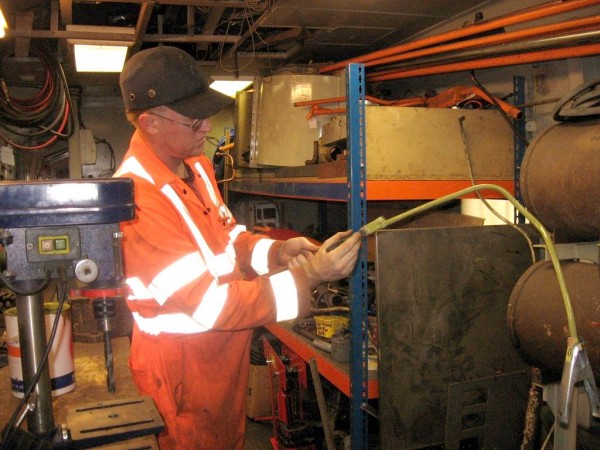 |
| © C15PS |
Fancy Getting Involved? click on the You Can Help page